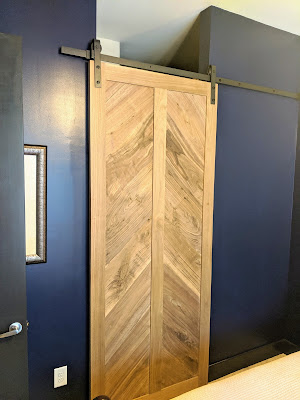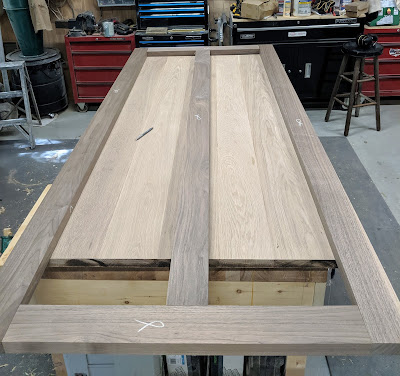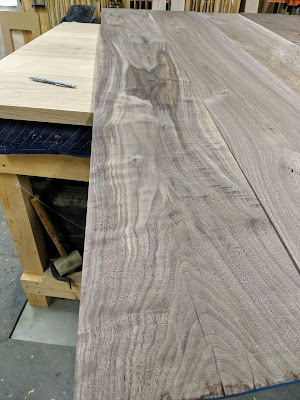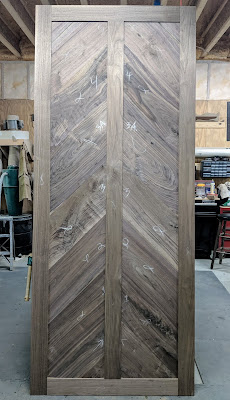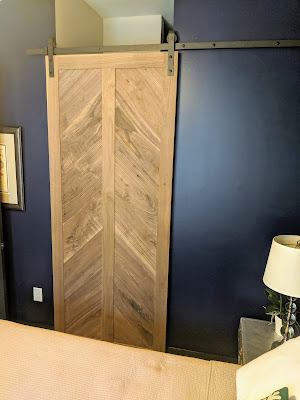Sliding Walnut Barn Door
Earlier in the Spring I was approached by a new, awesome, client of mine about building a sliding barn door for this oddly built closet in the guest room of their condo. I say “odd” because the ceiling is about 11’ tall and the closet door has no header, therefore no top of the doorway and hence, it didn’t have a door. The way the closet was oriented meant you could see into the closet from the dining area and living room; not what they wanted.
So, I met with my client at their condo and we went through several design iterations and material options. They decided on walnut for the material and a herringbone type pattern for the barn door. The barn door was going to measure 8 feet tall and about 42 inches wide. The door was also going to be a sliding barn door style so I was going to simple barn door hardware to hang the barn door.
Barn Door Design and Build
My client really wanted the barn door to have a rustic look and feel to it, so we decided to use #2 walnut for the panels. I also wanted the barn door frame to be sturdy and stable so I used First and Seconds (FAS) for the frame. [To learn more about what FAS and #2 lumber is, check out my Lumber Lingo blog post]
So, having the materials list for what I needed, I headed off to the lumber yard in search of the perfect boards. In this case, I needed four 8/4 (FAS) thick by 5+” wide boards for the frame and several 4/4 (#2) thick boards that needed to be as wide as possible.
Here is my 8/4 FAS walnut stock, these are 10 feet long to give me the desired 8 foot finished length for the barn door height.
Next is the #2 4/4 walnut stock. These were 8 foot in length and each board was going to be cut end-to-end to give me a consistent grain pattern across the barn door...this will make more sense later.
Once I had the rough material I wanted to start by building the frame first. I cut the rough material down to about 3 inches or so over final length.
Next, the pieces were run across the jointer to get one face nice and flat. This is a very crucial step in the build because if these pieces are not flat, the final barn door will be bowed or twisted. Lumber selection is crucial here, but not an exact science; wood has tension in it, some more than others, so I had to make 100% sure these were straight before proceeding.
After I was happy with them being straight, it was over to the planer to take them down to their final thickness. I had originally thought I wanted these frames to be 1.5 inches thick, but after thinking about it for a while, I decided to go to about 1-5/16. The main reason was weight. I didn’t want the door to be too heavy for both installation reasons as well as operationally.
Once everything was planed flat, I went back to the jointer to square the edges to the side and then used the table saw to cut them to their final width. I then went back to the miter saw and cust all the pieces to final length to get them ready for joinery and dry assembly.
For the joinery, I went with using my Festool Domino. Don’t worry, if you do not have a Domino, you can use standard mortise and tenon joint or another method of slip tenon joinery with your router. Here is a shot of the frame dry assembled.
Now that I had the frame complete, I could turn my attention to the panels. Again, we went with #2 grade walnut here. The reason for this is #2 grade lumber has a lot more “defects” in it; more knots, more crazy grain, etc. My client wanted a more rustic look so I think this was the perfect choice.
I followed the same process of milling the lumber as for the frame; using the jointer to make everything flat, then the planer to mill to final thickness. In this case, the final thickness was about 3/8 of an inch. I then laid the boards on the bench to get an idea of how I wanted the boards to be laid out in the barn door frame. Here you can really see the difference between the FAS wood in the frame and these #2 panels. Lot’s of grain, some purple coloring, knots...it looks awesome!
Next, it was time to work on laying out the panel boards into the frame. The inside edges of the frame got a 3/8 inch groove routed into it, on center, to receive the panels. I wanted the first piece to fit right into the corner so I could use it as my sort of cornerstone for laying out the rest of the pieces.
After that first piece was fit perfectly, it was just a matter of double checking my measurements, making sure everything was sitting on a perfect 45 degree angle and keep cutting.
Here is a shot of the whole door dry fit and ready for final sanding and assembly. If you look closely you will see where I labeled each panel “1” and “1”, “2” and “2”, etc across the panels. That means that those left and right panels came from the same board in a continuous grain pattern. Just a little detail to take into account when designing furniture to really make the piece stand out a little bit more. It is important to note that these panels are completely free-floating and are not glued to each other nor to the frame itself. This will add to the rustic look and account for wood movement across this 8 foot span.
Here is the final barn door, all assembled and sanded but...no finish! What? Yeah, the client wanted to keep the wood raw as they really liked the way it looked. I can’t disagree too much because it does add to the rustic appeal of the barn door, but man did those colors in the panel pop out when I put a little mineral spirits on it to see what it would have looked like with an oil finish.
Barn Door Installation
As mentioned, this door was designed to be a sliding barn door so I used this U-Max sliding door kit. I have used these kits several times in the past and they are very straightforward and easy to install. This particular kit is designed for a 42-48 inch door so the overall length of the track is 96 inches (8 feet) and our opening was only 40 inches so it was perfect. They do make several other kits for single doors, double doors and so on. And, best of all, the are reasonably priced!
So, I found the studs in the wall and lined up mounting holes the track to meet up with the studs and drilled my pilot holes into the wall. I used a level on top of the track to ensure everything was perfectly level so the door did not want to roll on its own. With the pilot holes drilled I could use the supplied lag bolts and spacers to install the track to the wall. Mounting the door is as simple as just lifting it over the track and setting into place on the rollers.
I think the barn door turned out great and my client is super thrilled with how it turned out as well. I was a little skeptical of not putting a finish on it, but I can see why it would be appealing in this case. I think the use of the #2 wood for the panels is spot on and looks amazing. Using the FAS lumber for the frame makes the frame sort of blend into the barn door and does not distract from the main attraction, which are the panels.
Conclusion/Feedback
So, that is all for this build. It was a lot of fun! Let me know what you think of the project in the comments. If you are interested in your own version of a barn door like this, or any other project, please contact me using the form below.
Thank you!!
Disclosure: Some links in this article are affiliate links meaning, I may get a small commission if you purchase anything from these links. Thank you for your support!
